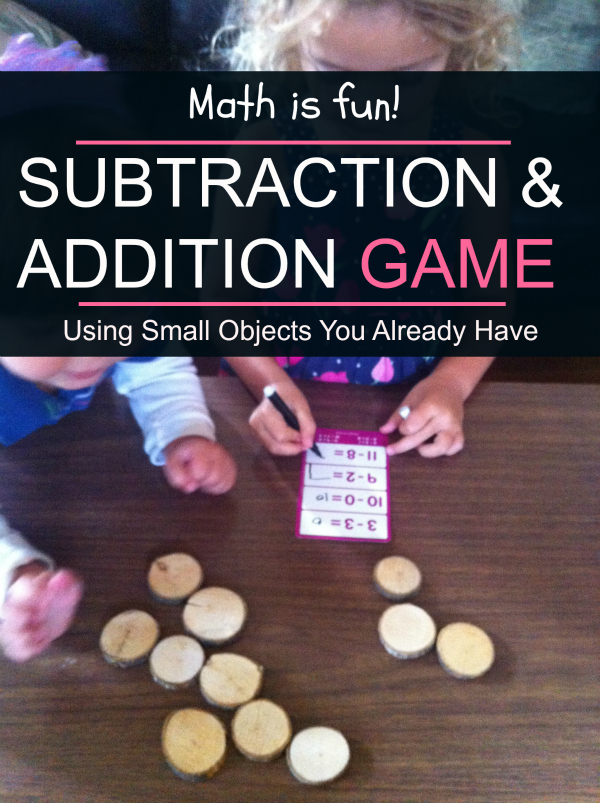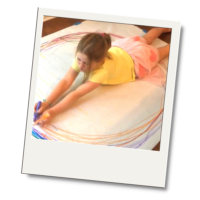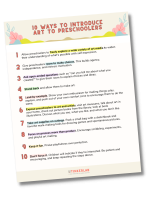Do you have a child who’s interested in math? Or maybe you have one who’s struggling, and you’re searching for a way to make it more relevant and fun?
Problem Solving Skills
This is, ahem, the very first math post I’ve ever written. My oldest child is 4, and has taken a huge interest in math, so it might just be the first of many. Fingers crossed.
If you know my blog, you’ll know me as an artsy-DIY-experiment kind of gal, and recognize that this post goes waaaaaaay out of my comfort zone, but if you need a little proof that I’m sort of qualified to talk on this subject, I took high school calculus (thanks Mrs. Tracey!) and I’m really good at counting 🙂 I’m also an advocate for creative and critical thinking, child-directed learning, and math games can help children develop problem solving skills.
Okay, so this is how this game came about…
My kids and I were on a Target run, and did the obligatory cruise down the $1 lane when 4-year-old N spotted a pack of dry erase subtraction cards (see the photo below).
She eagerly asked if we could get them and my first thought was…
“um, no, you don’t even know how to add numbers, let alone subtract them!”
But after a beat, I put on my improvisational hat and said “yes, of course, that will be fun,” and I imagined that she’d simply enjoy the process of drawing all over them.
When we got home she wanted to know how the cards worked, so we pulled them out.
Applied Math
Math can be so abstract and the only way I knew how to communicate the principles of subtraction was with the assistance of small objects that we could add and subtract. I’m sure I learned how to add this way, and I’m hardly claiming originality here.
I took out our basket of tree cookies (sliced up branches), and removed twelve of them, since the highest number on the cards was 12. We had tree cookies, but you could use coins, crayons, blocks, pom-poms, or any other small object that you have handy.
She can read numbers, so we started with the first problem: 3-3=
N held her dry erase marker carefully above the worksheet and waited for my next move.
I separated three cookies from the pile and asked her how many pieces we had. She said “3.”
I proceeded: “Okay, so if we take 3 away (and I swiped them aside), how many are left?”
“Zero!” she yelled, loud enough for the neighbors to hear (they’ve told me that we’re kind of loud…eek).
“Exactly,” I said.
Cool Math
After this first round, she was on a roll. As we moved through the problems, she would set up the cookies for the first number, and then take them away for the second, and mostly needed me as her cheerleading section. And her little 2-year old sister got into the spirit too, yelling out numbers across the table. Seriously, math is cool and fun, and great for building problem-solving skills.
Also, I never thought you could skip addition and go straight for subtraction!?
Have you tried teaching your child math this way? While we used pre-made cards, you could easily make up your own worksheet by hand or on your computer.
Do you think you’d give this a try?
 If you like what you see here, we’d love to have you join our 7000+ member community on Facebook.
If you like what you see here, we’d love to have you join our 7000+ member community on Facebook.





I’ve never heard of tree branch cookies as a math manipulative…cool! You could always show your little one how addition is the inverse of subtraction. It doesn’t actually matter which is taught first. They go together!
Hi Windy,
We happened to be building with tree cookies that week, so it felt like a natural object for us to use. I’m glad that you mentioned that subtraction and addition go together — you sound like more of an expert at this than me 🙂 You’re absolutely right about that. As long as it’s all introduced when the child is ready and done in a playful manner, it’s fun and a child will be invested in the “work.”
Cheers,
Rachelle
Don’t you love those $1 bins at Target? 🙂 My son is a bit older and we still use manipulatives a lot in his math practice. And you’re right, anything and everything can work as long as it keeps child’s interest. By the way, in your post you say that you are “artsy-DIY-experimenting kind of gal”. Well, math can be all this. For example, exploring mathematical knots (http://www.moebiusnoodles.com/2012/08/knot-theory-for-young-kids/) or weaving patterns (http://www.moebiusnoodles.com/2012/07/weaving-mathematics/) can lead to beautiful mathematical creations that are very engaging for the little ones and for their parents.
Hi Yelena!
I do love those bins, but I have to be careful less our house is over-run by all that stuff! I completely agree with you about math and art, but given that I’ve NEVER shared a math post on my blog, I thought I should qualify my credentials 🙂 I’m also glad that you and Windy shared that the little pieces we used are called manipulatives. Now that you mention it, I’ve heard that word, but didn’t make the connection.
Take care,
Rachelle
I hope this link will be usefull
http://mathskillbuilder.org/addition_subtraction_1-10_strategy.html
Here you can learn addition and subtraction strategies. It is free
Thanks Fred your link is really helpful , but the Math fractions they give us many concepts and many children’s are struggling to understand it , but if we learn them in an easy way they all are understood perfectly and quickly